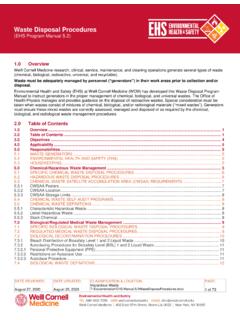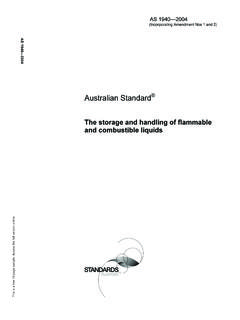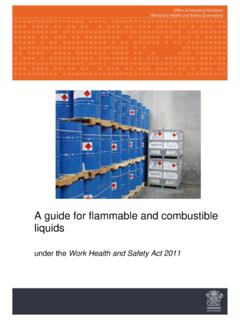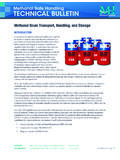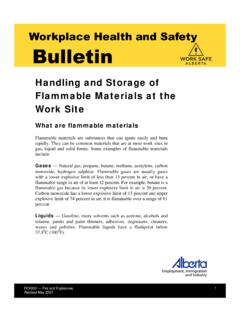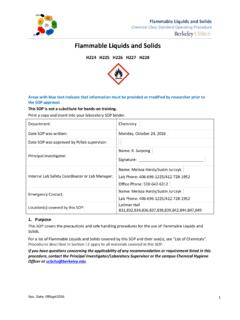Transcription of Compressed Gas Cylinder Storage and Handling
1 Revised 4/20/2021 Compressed Gas Cylinder Storage and Handling /Users/dianedeely/Desktop/remote work/Comms/EHS mtg w: Dory/Compressed_Gases .docx Overview Compressed gas cylinders are used in many workplaces to store gases that vary from extremely flammable (acetylene) to inert (helium). Many Compressed gas cylinders are stored at extremely high pressures (up to 2,500 pounds per square inch gauge or PSIG). A sudden release of these gases can cause a Cylinder to become a missile-like projectile capable of penetrating a concrete block wall. If handled properly Compressed gas cylinders are safe. If handled improperly, the same cylinders can present a severe hazard to you and the surrounding area. Applicability This Update applies to all faculty, staff, students, visitors, and contractors working with Compressed gas cylinders.
2 The Fire Department of the City of New York (FDNY) is the authority having jurisdiction over the Storage and Handling of Compressed gas cylinders. Responsibilities Directors and Principal Investigators (PIs) are responsible for ensuring that all staff know the Compressed gas safety practices and are trained in proper Storage , Handling and incidence response. Users of Compressed Gas Cylinders must read, understand, and follow the markings on the Cylinder , the label(s) on the Cylinder , the Safety Data Sheets (SDSs), and the laboratory s standard operating procedures. Users must ensure safe Storage of cylinders and follow procedures outlined in this Update. Vendors must deliver properly labeled Compressed gas cylinders with safety caps in place.
3 Environmental Health and Safety (EHS) is responsible for providing guidance and information on Compressed gas Cylinder use, transportation, and Storage . Procedures LABELING Compressed gas cylinders shall be legibly marked with either the chemical or the trade name of the gas. Such marking shall be by means of stenciling, stamping, or labeling, and shall not be readily removable. Whenever practical, the marking shall be located on the shoulder of the Cylinder ; OSHA Standard 29 CFR (b) (1) (ii). A durable, non-removable label must be present on the Compressed gas Cylinder . A Compressed gas Cylinder that does not clearly identify its content by name should not be accepted for use. Do not rely on color-coding to identify the contents of a Cylinder .
4 Color-coding is not a reliable means of identification; Cylinder colors vary from supplier to supplier, and labels on caps have no value as many caps are interchangeable. Tags should be attached to the gas cylinders on which the names of the users and dates of use can be entered. If the labeling on the gas Cylinder becomes unclear or defaced so that the contents cannot be identified, the Cylinder should be marked contents unknown and the manufacturer must be contacted regarding appropriate procedures for removal. Handling CYLINDERS Serious accidents may result from the misuse, abuse, or mishandling of Compressed gas cylinders. Workers assigned to the Handling of cylinders under pressure should be properly trained.
5 Compressed gas cylinders must be handled as high-energy sources and therefore as potential explosives. Follow the rules below to help control the hazards of Handling Compressed gas cylinders. Accept only cylinders approved for use in interstate commerce for transportation of Compressed gases. Secure cylinders in a boot or by a chain to a fixed support to prevent them from being dropped or from falling over. Do not remove or change numbers or marks stamped on cylinders. Cylinders should not be banged, dropped, or permitted to strike each other or against other hard surfaces. Never use Compressed gas to dust off clothing. This could cause injury to the eyes or body and create a fire hazard. Clothing can become saturated and burst into flames if touched by an ignition source such as a spark or open flame.
6 2 CONTINUED: Compressed Gas Cylinder Storage and Handling Do not use the valve cover to lift cylinders; they could be damaged and detached causing the Cylinder to drop on a hard surface, possibly resulting in an explosion. Storage The rules listed below will minimize hazards when storing Compressed gas cylinders: Store cylinders upright and secure them with a chain, strap, or cable to a stationary building support ( a structural beam) or to a Cylinder cart to prevent cylinders from tipping or falling. See Figures for examples. Figure Figure Figure Figure Proper Compressed Gas Cylinder Storage in a laboratory, secured in a rack. Proper Compressed Gas Cylinder Storage in a Laboratory, secured by straps.
7 Proper Compressed Gas Cylinder Storage at a Construction Site, secured by chain. Proper Compress Gas Cylinder Storage , secured by chain. Place cylinders in a location where they will not be subject to mechanical or physical damage, heat, or electrical circuits to prevent possible explosion or fire. Separate Compressed gas containers from each other based on the hazard class of their contents. Oxygen cylinders should be kept at a minimum of 20 ft away from flammable gases, liquids, solids, greases and oils. Combustible waste must be kept a minimum of 10 ft away from Compressed gas containers and systems. As per FDNY fire code regulations, flammable gas indoor Storage of 3,500 SCF ( m3) or less must be located not less than: o 20 feet (6,096 mm) from all classes of flammable and combustible liquids, oxidizing gases and readily combustible materials, such as paper and combustible fibers.
8 O 25 feet (7,620 mm) from open flames, ordinary electrical equipment or other sources of ignition. o 50 feet (15,240 mm) from air-conditioning equipment, air compressors and intakes of ventilation. o 50 feet (15,240 mm) from other flammable gas Storage . Store cylinders in a dry, well-ventilated area away from flames, sparks, or any source of heat or ignition. Mark Cylinder Storage areas with proper precautionary signs, such as Storage of flammable , oxidizer, or toxic materials. Keep valve protection caps on cylinders at all times except when the Cylinder is actually being used or charged. Cylinder valves should remain closed. Never plug, remove, or tamper with any pressure relief device.
9 Under normal conditions, these containers will periodically vent the product. Cylinders should not be exposed to an open flame or to any temperature above 125 degrees Fahrenheit. Cylinders should not be exposed to continuous dampness, stored near salt or other corrosive chemicals or fumes. Corrosion may damage cylinders and cause their valve protection caps to stick. Mark cylinders to be returned to the vendor as Empty or MT and segregate the empty cylinders from full cylinders. Compressed gas cylinders require hydrostatic testing every 10 years. Month and year of the last test are stamped on the shoulder of the Cylinder . Return any cylinders that have passed the 10 year mark to the vendor.
10 Liquefied flammable gas cylinders should be stored in an upright position, or such that the pressure relief valve is allowed to remain in the gas phase. Cylinders loaded with liquefied gas are not completely filled; a small vapor space is left to allow for expansion if the Cylinder is heated. Use only approved containers to store and transport liquid nitrogen. Containers should have vented lids to prevent pressure build up and spillage when carried. Consult the EHS Liquid Nitrogen Update for further guidance. In non-laboratory areas, a FDNY permit is required for storing, Handling or using Compressed gases in excess of the amounts listed in Table (1) of the FDNY Fire Code: 3 CONTINUED: Compressed Gas Cylinder Storage and Handling TABLE (1) PERMIT AMOUNTS FOR Compressed GASES Type of Gas Amount in Standard Cubic Feet Corrosive 400 flammable 400 Highly toxic Any Amount Nonflammable and non-oxidizing, except carbon dioxide 3,000 Carbon dioxide 4,500 Oxidizing 504 Pyrophoric Any Amount Toxic Any Amount Unstable (reactive) Any Amount Water reactive Any Amount The FDNY sets Storage limits on the amount of gases that may be stored in a laboratory.
